In this Issue
- Codling moth: updated spray dates table
- Woolly apple aphid: colonies are starting; monitor trees now
- Blister mites on apple, pear: no action at this time of year
- Peach aphids: treat now, or ignore, as they will migrate away in mid to late June
- Cherry powdery mildew: time to scout for new lesions to determine if a spray is warranted
WHAT TO WATCH FOR
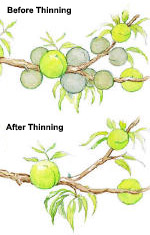 Examine leaves of apple and cherry, and fruit of peach/nectarine, for powdery mildew lesions. Apply a fungicide where necessary to prevent additional spread.
Examine leaves of apple and cherry, and fruit of peach/nectarine, for powdery mildew lesions. Apply a fungicide where necessary to prevent additional spread.- Thin apples when they are 1/2-inch in diameter, and thin peaches now, or in the next few weeks (earlier is better). On apples, thin clusters to one apple and to six inches apart. Thin peaches to 4 to 6 inches apart.
APPLE, PEAR
Codling Moth
Codling moth treatment dates updated
View a pdf of the spray timing table. Be sure to read the instructions at the top of the page, for how to read the table.
Dates are updated for all locations. Northern Utah location dates have shifted a few days later while southern Utah dates are now a few days earlier than the May 3, 2024 advisory.
Treatment
- Options for Commercial growers.
- Options for Residential:
| Product Name | Efficacy | Residual Length (days) | Comments |
|---|---|---|---|
| CONVENTIONAL | |||
| Spectracide Triazicide (gamma-cyhalothrin) | Good to Excellent | 14-17 | wait 21 days to harvest |
| Monterey Bug Buster 11 (esfenvalerate) | Good to Excellent | 14-17 | wait 21 days to harvest |
| Bonide Fruit Tree & Plant Guard (lambda-cyhalothrin) | Good to Excellent | 14-17 | wait 21 days to harvest |
| Bonide Malathion; Hi Yield Malathion | Good | 5-7 | max 2 applications; some products are pears only |
| GardenTech Sevin (zeta-cypermethrin) | Good to Excellent | 14-17 | wait 14 days to harvest |
| ORGANIC | |||
| AzaSol, EcoGarden (azadirachtin) | Good | 7-10 | purchase online |
| Cyd-X (codling moth virus) | Good (if populations are low) | 7 | works best when used at beginning of generation; expensive and purchase online |
| oil such as All Seasons Oil, EcoSmart, Neem oil | Good on eggs only | 3 | recommended for first application of the generation only |
| Ortho Fruit Spray; Fertilome Fruit Tree Spray; Safer End All; Bonide Orchard Spray (all contain pyrethrin) | Good | 3-5 | |
| Monterey / Fertilome Spinosad; Captain Jack's Deadbug Brew; Natural Guard (all contain spinosad) | Good | 10 | max 6 applications per season; if applying to peach or cherry, can re-apply after 7 days |
Woolly Apple Aphid
Aphid colonies are growing; treat early for best control
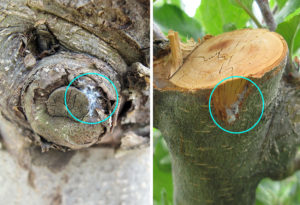
Woolly apple aphids are showing up in the warmer areas of the Wasatch Front. We cannot provide a predicted date of their appearance, so it is important to scout your own trees to determine when and if a treatment is needed.
Start by looking for aphids around old pruning scars or other wounds, and on root suckers.
These aphids are different from typical aphid species in that they feed on twigs, bark and roots, and have a cottony covering on their bodies.
Treatment
If woollies are a problem every year, it is best to treat them early. Because of the aphid’s thick, waxy coating, it is important to spray the tree to drip, to reach the aphid bodies.
- Backyard growers can use insecticidal soap+1% oil (organic), or mix 1% oil with Spectracide Triazicide or GardenTech Sevin, aimed directly at the colonies.
- Options for commercial growers
Appleleaf and Pearleaf Blister Mites
Moderate amounts of blisters do not reduce the vigor of the plant or affect fruit
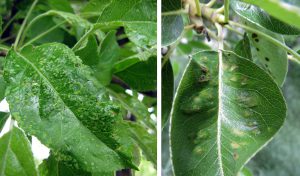
There have been many reports of “spots” appearing on apple and pear leaves. These are actually tiny blisters, and inside each one are dozens of microscopic mites called blister mites. The minute, 4-legged mites feed inside the blisters all summer.
On apple leaves, the blisters age to brown, and on pear leaves, they age to a dark brown/black. After harvest, the mites leave the blisters and migrate to leaf buds to spend the winter.
Treatment
Spraying now could prevent additional blisters, but will not mitigate existing blisters. The best timing is in early fall as the leaves start to color.
Options to use now or in early fall include carbaryl, sulfur, or 1% horticultural oil.
PEACH/NECTARINE, APRICOT
Peach Aphids
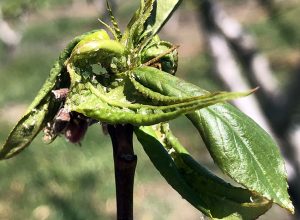
Generally, can ignore these
The cooler spring conditions have been optimal for aphids, especially green peach aphid. They overwinter as eggs, and hatch around the time of bud break. At this time their feeding on peaches is waning, and in the next few weeks, they will migrate to other hosts for the summer.
Backyard trees can tolerate the aphid activity. Keeping the aphids around will help preserve and promote beneficial insects. Plus, trees will put out another flush of foliage and hide the current damage.
Treatment
- Residential: We recommend no treatment. The best option is insecticidal soap, but the soap must come into contact with the aphids, and they are tucked tightly within the leaf curls.
- Commercial growers can use Admire Pro, or a generic.
CHERRY
Powdery Mildew (Tart Cherry)
Scout lowest tree leaves for infection
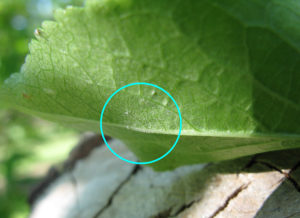
Cherry powdery mildew lesions may start to show up on tart cherries in the next few weeks. The fungus overwinters as resting spores in fallen leaves, on the orchard floor, or in bark crevices.
Infections on new leaves occurs when spring rains or summer irrigation increases the humidity under the trees, causing the resting spores to release and spread. This pathogen needs 90% humidity and temperatures between 50-78°F for infection to occur.
Leaves, fruit, and fruit pedicels can all become infected. Monitor for the earliest infections on leaves near the trunk, and on the lowest, interior twigs (where humidity is highest).
Treatment
Sprays are recommended as soon as the first lesions are spotted, because prevention is the best management option for powdery mildew.
Continue sprays at 7 to 14-day intervals until growth hardens off.
Options for commercial growers.
SMALL FRUITS
Raspberry Horntail
If raspberry horntail has been a problem, treat for adults in late May to early June
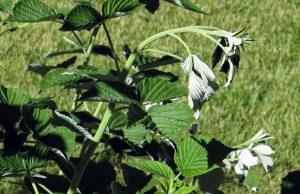
Raspberry horntail is a sawfly that lays eggs in canes. The eggs hatch into larvae that then feed inside the upper canes, causing the tops to wilt and die. Adult horntails will soon begin emerging from canes that were infested last year, towards the end of May.
If raspberry horntail is a problem in your area, an insecticide application to prevent egg-laying should go on at these timings:
- May 22 – 28 for warmer areas along the Wasatch Front
- June 1 – 5 for cooler areas along the Wasatch Front
- June 10 for Cache County
- June 20 for Garden City, UT
Treatment
An insecticide targets the adults (eggs are laid inside the canes).
Synthetic pyrethroids (or the organic, pyrethrin) and Sevin are effective. Spinosad is another option, but unproven.
A second application should be applied 10-14 days later, depending on product residual and when bloom time is projected to begin. Avoid treating during bloom.
